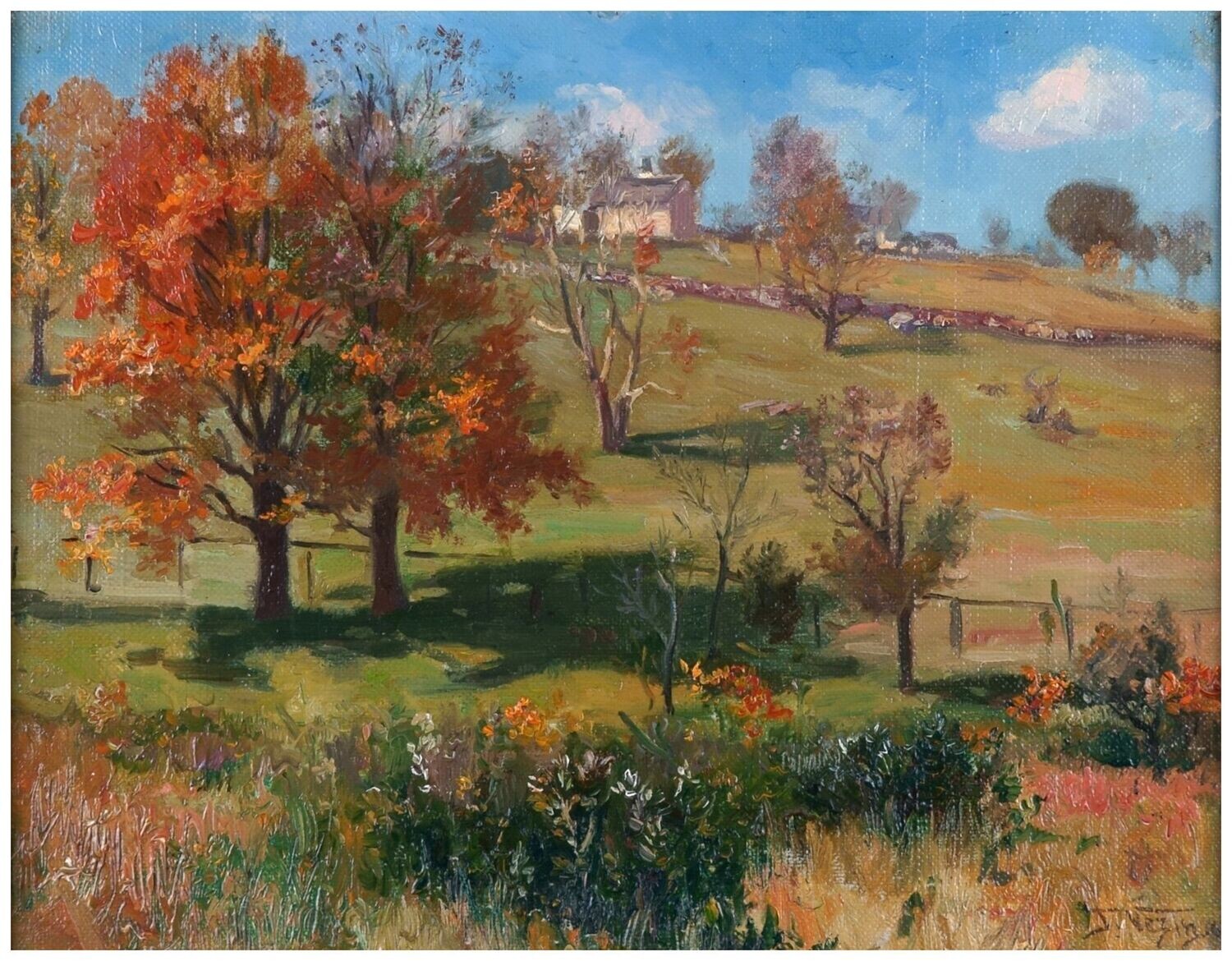Vezin, Frederick (1859-1933), Herbstlandschaft im Sonnenlicht, 1905
Frederick Vezin(1859 Torresdale Philadelphia – 1933 Düsseldorf), Herbstlandschaft im Sonnenlicht , Öl auf Leinwand, auf Karton kaschiert, 32 x 41 cm (Innenmaß), 44 x 51 cm (Rahmen), unten rechts mit „F. Vezin. [19]05" signiert und datiert.
- Karton leicht gewölbt, kleine unauffällige Retusche mittig an der Oberkante des Bildes.
Exposé als
PDF
- Indian Summer -
Das Gemälde wirkt zwar skizzenhaft, ist – wie die Signatur rechts unten belegt – von Frederick Vezin aber dennoch als vollendetes Kunstwerk verstanden worden. Und gerade das Skizzenmäßige führt zum Verständnis des sicherlich in der Landschaft selbst entstandenen Bildes: Die Naturphänomene sollen im Augenblick ihrer Beobachtung künstlerisch zur Darstellung gebracht werden. Dies geschieht nicht, indem die Natur akribisch abgezeichnet wird, sondern – und hier folgt Vezin der Lehre des Französischen Impressionismus – indem die Natur in ihrer visuellen Fülle zur Veranschaulichung kommt. Das Auge des Künstlers taucht gleichsam in die Visualität der Natur ein, die durch seine Hand bildlich manifest wird. Daher ist das Gemälde kein Abglanz der Landschaft, sondern ihre künstlerische Intensivierung.
Zur Intensivierung gehört auch, dass sich der Bildvordergrund – dem Sehfeld entsprechend – einer detailorientieren nahsichtigen Betrachtung entzieht. Stattdessen bewirkt die spachtelartig aufgetragene Farbe, die in ihrer vertikalen Struktur der Struktur des floralen Bewuchses entspricht, dass die Natur in ihrer farblichen Substanz haptisch erfahrbar wird.
Zugleich schafft der in seiner konkreten Gegenständlichkeit unbestimmt bleibende Vordergrund einen atmosphärischen Raum, welcher sich mit dem eigentlichen Protagonisten des Bildes, der in Rot- und Brauntönen aufflammenden Baumgruppe, verbindet. Auch hier sind die Blätter mehr getupft als klar konturiert. Eben diese ‚Skizzenhaftigkeit‘ eröffnet eine Seherfahrung, die die Landschaft in ihrer visuellen Fülle zugänglich werden lässt und dadurch ihr Wesen erschließt.
Über diese Fülle hinaus wird die Landschaft als Ordnungsfüge aufgezeigt, indem die Komposition des Bildes die Komposition der Landschaft sichtbar werden lässt. So bildet die Baumgruppe einen deutlichen dunkelgrünen Schattenwurf, der sich in den Schattenwürfen der Bäume dahinter wiederholt. Es entsteht eine musterförmig bestimmte diagonale Achse ins Bild hinein, die von der Landschaft selbst so komponiert worden ist.
Genau besehen ist diese Landschaft eine Kulturlandschaft: Im unteren Bereich durchläuft ein Zaun, im oberen ein niedriger Steinwall von links nach rechts das Bild – zwei ebenfalls stark kompositorisch wirkenden Elemente. Und auf Kuppe des Hügels ist als hellste Fläche im Bild ein Steinhaus in die Landschaft eingebettet. Natur und Kultur gehen hier eine harmonische Synthese ein, wodurch das Gemälde einen arkadischen Zug bekommt.
Um der Landschaft möglichst viel Raum zu geben, ist die Horizontlinie hochgezogen und dennoch kommt auch der Gestaltung des Himmels eine entscheidende Bedeutung zu. Die sich mit den Formen der Bäume verbindenden Wolken durchziehen einen strahlend blauen Himmel. Für den europäischen Blick evoziert ein solcher Himmel eine Sommerlandschaft. Entsprechend ist der blaue Himmel innerhalb von Jahreszeitenzyklen für den Sommer reserviert und auch der Französische Impressionismus ist vor allem eine Ode an den Sommer. Auf dem Gemälde von Vezin steht der gleißend blaue Himmel jedoch über einer Herbstlandschaft, deren Bäume teilweise sogar schon entlaubt sind. Daher ist davon auszugehen, dass das Bild nicht in Europa, sondern den USA entstanden ist und den sprichwörtlich gewordenen Indian Summer veranschaulicht, was Frederick Vezin zu einem Pionier der amerikanischen Landschaftsmalerei macht.
zum Künstler
Frederick Vezin war der Sohn eines in die USA ausgewanderten Franzosen und einer deutschstämmigen Mutter. Dies prädestinierte ihn dazu, den künstlerischen Austausch zwischen der alten und der neuen Welt zu befördern. Nachdem er bereits seine Schulzeit teilweise in Deutschland verbracht hatte, nahm er 1876, im Alter von 20 Jahren, das Studium an der Düsseldorfer Kunstakademie auf, wo er unter anderen bei Peter Janssen dem Älteren, Eduard von Gebhardt und Wilhelm Sohn lernte. 1883 schloss er das Studium ab, etabliert sich in München und zog 1895 wieder zurück nach Düsseldorf, wo er bis zu seinem Tod 1933 seinen Lebensmittelpunkt hatte.
Als gebürtiger US-Amerikaner reiste er immer wieder in die USA und wurde auch dort zu einem gefragten Porträt- und Gesellschafsmaler. Sein künstlerisches Talent zeigte sich aber vor allem in der Landschaftsmalerei. Am Impressionismus Frankreichs geschult, entwickelte er eine virtuose Farbgebung und freie Pinselführung, die dennoch an das landschaftliche Motiv zurückgebunden bleiben, so dass die Landschaft selbst auf eine ganz neue Art und Weise erschlossen wird. Dabei wandte sich Frederick Vezin vor allem der Landschaft seines Heimatlandes zu und wurde damit zu einem Pionier der modernen US-amerikanischen Landschaftsmalerei.
„Durchaus modern in seiner coloristischen Auffassung, aber auch in der Wahl der Motive ist der in Philadelphia 1859 geborene Frederik Vezin, […]. [Er schuf Werke], die großes landschaftliches Verständnis verriethen.“
Friedrich Saarschmidt
Auswahl öffentlicher Sammlungen, die Bilder von Frederick Vezin besitzen
Stadtmuseum Landeshauptstadt Düsseldorf , Künstlerverein Malkasten Düsseldorf , Kölnisches Stadtmuseum
Auswahlbibliographie
Hans Vollmer (Hrsg.): Allgemeines Lexikon der Bildenden Künstler von der Antike bis zur Gegenwart. Begründet von Ulrich Thieme und Felix Becker, Leipzig 1940.
Friedrich von Boetticher: Malerwerke des 19. Jahrhunderts. Beitrag zur Kunstgeschichte. Band 2/2, Dresden 1901.
Friedrich Schaarschmidt: Zur Geschichte der Düsseldorfer Kunst. Kunstverein für die Rheinlande und Westfalen, Düsseldorf 1902.
Hans Paffrath (Hrsg.): Lexikon der Düsseldorfer Malerschule 1819–1918. Band 3: Nabert–Zwecker, München 1998.

